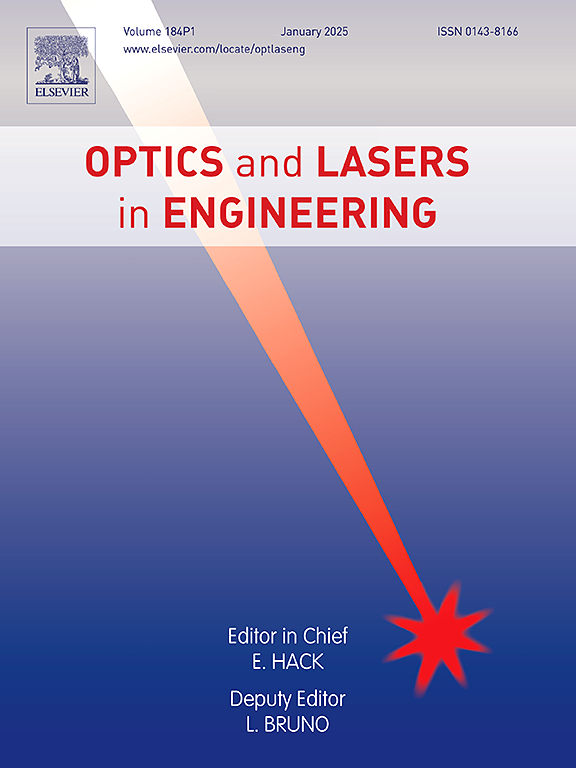基于水下线扫描激光雷达的激光条纹鲁棒中心线提取方法
IF 3.5
2区 工程技术
Q2 OPTICS
引用次数: 0
摘要
水下线扫描激光雷达(ULSL)可以从激光条纹图像中重建水下目标的三维(3D)剖面信息,在海底地形测绘、海洋生物研究、导航和军事目标探测等方面发挥着重要作用。激光中心线提取算法的性能对 ULSL 的探测范围和精度至关重要。然而,海水中光学环境条件较差--衰减大、反向散射强--这将严重阻碍用传统的空气图像算法提取激光中心线。对于 ULSL 而言,迫切需要一种特殊的激光中心线提取算法。为此,本文建立了水下线激光传播模型,从理论上分析了线激光沿传播方向的能量分布。在此基础上,提出了一种用于水下激光中心线提取的距离梯度区域能量(DGRE)方法。距离梯度图消除了反向散射的影响,距离梯度区域能量图抑制了残余背景噪声的影响。因此,在减轻反向散射和其他背景噪声影响的同时,也解决了无法提取激光中心线的问题。与其他方法相比,我们的方法在水衰减系数为 0.28/m-1@532nm 的情况下,探测距离可达 25.0 米,探测精度为 50.0 毫米,而其他方法最多只能达到 13.4 米。本文章由计算机程序翻译,如有差异,请以英文原文为准。
Robust centerline extraction method of laser stripe based on an underwater line scanning lidar
The underwater line scanning lidar (ULSL), which can reconstruct the three-dimensional (3D) profile information of the underwater target from laser stripe images, plays an important role in seabed topography mapping, marine biological research, navigation and military targets detection, etc. The performance of the laser centerline extraction algorithm is crucial to the detection range and accuracy of ULSL. However, the poor optical environment conditions in seawater—the large attenuation and strong backscattering—will seriously hinder the extracting of laser centerlines with traditional algorithms for in-air images. For the ULSL, a special laser centerline extraction algorithm is urgently needed. For this reason, in this paper, an underwater line laser propagation model is established, which theoretically analyzes the energy distribution of the line laser along the propagation direction. On this basis, a distance gradient region energy (DGRE) method for underwater laser centerline extraction is proposed. The influence of backscattering is eliminated by distance gradient map, and the effect of the residual background noise is suppressed by distance gradient region energy map. As a result, the problem of inability to extract the laser centerline can be solved meanwhile mitigating the effects of backscatter and other background noise. Compared with other methods, our method can achieve a detection distance of 25.0 m with a detection accuracy of 50.0 mm under the water attenuation coefficient of , while other methods can only reach a maximum of 13.4 m. Finally, an underwater 3D reconstruction experiment was carried out, and a good 3D imaging capacity is realized with this method.
求助全文
通过发布文献求助,成功后即可免费获取论文全文。
去求助
来源期刊

Optics and Lasers in Engineering
工程技术-光学
CiteScore
8.90
自引率
8.70%
发文量
384
审稿时长
42 days
期刊介绍:
Optics and Lasers in Engineering aims at providing an international forum for the interchange of information on the development of optical techniques and laser technology in engineering. Emphasis is placed on contributions targeted at the practical use of methods and devices, the development and enhancement of solutions and new theoretical concepts for experimental methods.
Optics and Lasers in Engineering reflects the main areas in which optical methods are being used and developed for an engineering environment. Manuscripts should offer clear evidence of novelty and significance. Papers focusing on parameter optimization or computational issues are not suitable. Similarly, papers focussed on an application rather than the optical method fall outside the journal''s scope. The scope of the journal is defined to include the following:
-Optical Metrology-
Optical Methods for 3D visualization and virtual engineering-
Optical Techniques for Microsystems-
Imaging, Microscopy and Adaptive Optics-
Computational Imaging-
Laser methods in manufacturing-
Integrated optical and photonic sensors-
Optics and Photonics in Life Science-
Hyperspectral and spectroscopic methods-
Infrared and Terahertz techniques
 求助内容:
求助内容: 应助结果提醒方式:
应助结果提醒方式:


